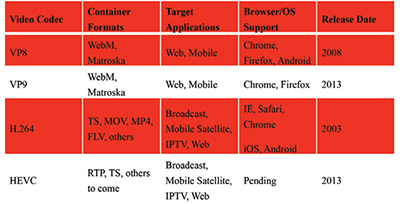Google Seeks to Expand VP9 Support

Wes Simpson
The latest iteration of Google’s video codec for Internet streaming applications is called VP9, and it is starting to gain traction in the turbulent market for video codecs. Introduced in mid-2013, VP9 is an open-source, royalty-free video compression format that is being positioned as a competitor to H.265/HEVC for web streaming and mobile video applications. Announcements in January heralded a growing base of support for the codec, with close to 20 manufacturers promising to create hardware implementations of VP9.

VP9 uses a traditional block-based encoding system based on the Discrete Cosine Transform, similar to MPEG-2 and AVC encoders. Standard concepts such as motion prediction and an efficient binary entropy coding scheme are used. VP9 supports “superblocks” at sizes up to 64 x 64, which improve coding performance for static images, and employs quadtree recursive variable block size subdivision down to 4 x 4 pixels, which perform better for images with a large amount of motion. The codec also supports a different type of coding transform called Asymmetrical Discrete Sine Transform (ADST), which produces a compressed video signal with smoother transitions at boundaries between adjacent blocks.
CONVERGING VIEWS
So how does VP9 compare to other codecs such as AVC and HEVC? Well, the only thing that is certain is that VP9 is better (higher quality at lower bit rates) than VP8 in all respects. Some studies have shown that VP9 is significantly better than AVC, and within a few percentage points of HEVC. Other studies indicate that VP9 is comparable to AVC and significantly worse than HEVC. As encoders become optimized, and more studies are performed, the results should start to converge, but it is important to consider the applications for the various codecs.
In comparisons published so far, VP9 seems to do better in testing that uses consumer-contributed video (not uncompressed test sequences) at very low bit rates. Some other evidence indicates that MPEG codecs are stronger at high bit rates and with pristine, uncompressed source material.
VP9 is the successor to VP8, a video codec introduced in 2008 by On2 Technologies, a company that was acquired by Google in early 2010. After the acquisition, Google began using VP8 for YouTube video delivery (along with HTML5), and subsequently made the source code available under an open-source license. Google has taken the same approach with VP9, finalizing the bitstream format and releasing source code for encoding and decoding in June, 2013. Fig. 1 shows a comparison of four different video codecs.

The evolution of video codecs over the past five years So far, Google’s new codec has achieved a small but significant amount of support in the market, particularly on the decode side. Browsers including Google Chrome and Firefox from Mozilla provide native HTML5 support for VP9. (Mozilla has a policy against incorporating codecs that require license payments, although a deal last year with Cisco has initiated efforts to support H.264 in Firefox.) VP9 bitstreams are typically wrapped inside the WebM container format, along with open source audio codecs such as Vorbis today and Opus in the near future. The popular open source, multiformat video player VLC has included support for VP9 in a recent update. FFmpeg, which is a bundle of open source tools and technologies, also introduced support for a VP9 player capability late last year. On the encode side, there are few commercial products as of yet, but these may be forthcoming in the near future.
The professional video industry's #1 source for news, trends and product and tech information. Sign up below.
GOOGLE’S MOTIVATION
Google developed VP9 to greatly reduce the bandwidth required for streamed videos, particularly for HD and larger video formats. Lower bit rates have obvious benefits for Google, as they will help reduce the amount of bandwidth needed to deliver streams to online viewers. Video file storage requirements will also be reduced, which becomes significant when one considers the 100 hours of video that is uploaded to You- Tube each minute.
Another objective for Google in creating VP9 was to promote widespread adoption of a technology within the marketplace that was unencumbered by third-party patents and related issues or royalties. In 2013, Google was able to license a group of 11 patents related to VP8 in a negotiation with MPEG LA (the leading MPEG intellectual property license pool). The terms of the license stated that the same group of patents could also be utilized by Google in the next generation codec, namely VP9. This could prove important in comparison to HEVC, which has indicated that royalties will be collected on a per-device basis.
IMPACT ON BROADCASTERS
From a practical standpoint, the biggest impact of VP9 on broadcasters will be on those organizations that are delivering video to viewers using mobile devices and web streams. As more consumer devices and platforms support the new codec, content producers will find it easier to distribute video to multiple devices that all have native support for the standard. Right now, broadcasters will most likely first encounter VP9 when uploading HD content to YouTube; widespread deployment for other applications will likely have to wait until commercial encoding is available. This could occur either in the form of a packaged encoder solution, or in the form of a service provider that offers VP9 as a menu choice. Momentum in support of the new codec could potentially increase now that the likes of ARM, Intel, Qualcomm, Panasonic, Samsung and Sony have agreed to provide support. Don’t be surprised if new VP9 products are forthcoming by the end of 2014.
Wes Simpson is an industry consultant and author of “Video Over IP, Second Edition,” from Focal Press. Your comments are welcome towes.simpson@gmail.com.
Wes Simpson is President of Telecom Product Consulting, an independent consulting firm that focuses on video and telecommunications products. He has 30 years experience in the design, development and marketing of products for telecommunication applications. He is a frequent speaker at industry events such as IBC, NAB and VidTrans and is author of the book Video Over IP and a frequent contributor to TV Tech. Wes is a founding member of the Video Services Forum.

